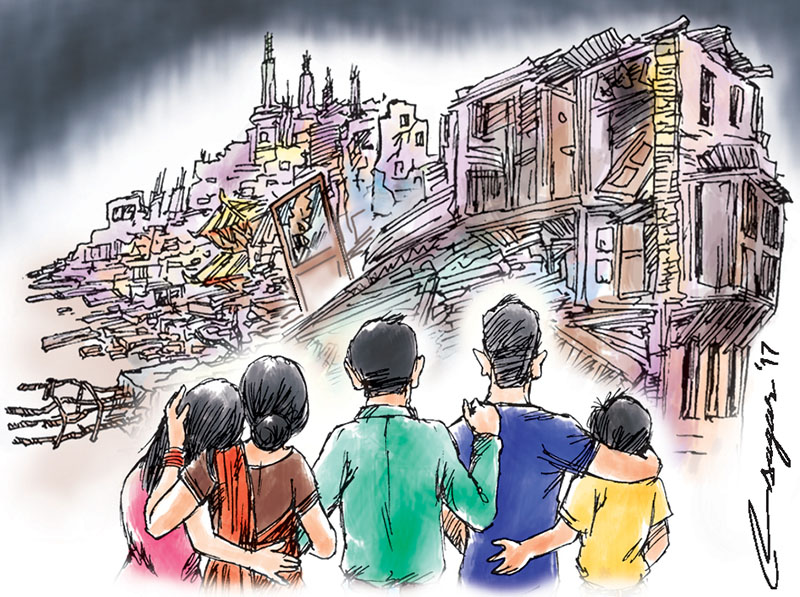Post-quake reconstruction: Can be a boon
The disrespect shown for the heritage does not bode well for the future of the country. Kathmandu has been famous for its three durbar squares. But it could have 43 of them had the 40 odd Rana palaces been constructed in the then prevailing indigenous architectural style instead of the neoclassical style
Nepal has not yet recovered from the shock of the high magnitude earthquake which occurred on April 25, 2015. This was one of the greatest banes that befell our country but examples suggest that it can be transformed into a boon if executed properly. When the earthquake hit Bechuan, China in 2008, the whole of the city had turned into rubbles; but it has been totally transformed into a tourist hub after the reconstruction in the same manner as the caterpillar turns into a butterfly.
The reconstruction was carried out in a breathtakingly high speed and correspondingly in an unbelievably short span of time. It can be gauged from the fact that temporary sheds housing 15 million people were ready in 10 days; transitional shelters for 12 million people were completed in 100 days; houses of 3.5 million people were repaired and strengthened in one or two years’ time the housing building of the rural and urban people was almost all completed.
Nepal Reconstruction Authority has been established to provide support to the earthquake victims; unfortunately, it has been moving at a snail’s speed thereby painting a gloomy picture in the Nepali horizon. However, like a silver lining in the dark cloud, a new Chief Executive Officer has lately emerged into the scene bringing an island of hope amidst the ocean of despair among the earthquake victims.
Nepal falls in a seismically vulnerable zone. So, it is a reality though harsh that Nepal has to learn to live with earthquakes. It is against this backdrop that our ancestors had developed earthquake resistant technology and used it in domestic architecture that can be seen glaringly in Jumla from the Licchavi times in view of the existing Licchavi period inscription in this district.
It consists of the use of twin timber sleepers put below the lintel and above, something which the existing building code recommends for the earthquake resistant construction of stone walled buildings. In the religious architecture also, it was used very extensively. This is the reason why Krishna Mandir of Patan constructed in the year 1637 stands very proudly as before despite the fact that it was jolted by several earthquakes after its inception, particularly those of the year 1834, 1934 and 2015 a few cracks notwithstanding.
Unfortunately, this construction practice remained confined and did not spill to the other districts, thereby, creating widespread devastation in the aftermath of the high magnitude earthquakes like the last time.
Despite the occurrence of large earthquakes in every 75 to 100 years, the identity of Nepal had remained intact. The genius loci of the place remained unharmed. But it appears that Nepal will be dotted not by buildings sporting pleasant indigenous architecture for which it has become a heart throb for myriads of tourists but by an unbecoming alien architecture.
The quest for more permanent materials on the part of the house owners has been forwarded as the reason for this unpleasant state of affair, but history suggests that the change of material does not come in the way of the retention of the form. The Greek temples of the likes of Parthenon, whom an American poet Emerson described as the gem of the crown put on by the queen earth, were formerly built in timber which was later converted into marble.
In Nepal, also the Siku Bahi inscription of the year 753 describes the use of stone instead of clay after the hands and the legs of the clay made images had been broken. But in both the cases, the form and hence the identity remained unchanged despite change in material.
It is not only in the arena of architecture that identity can be retained but also in the case of the planning of the settlements. We have the examples of the planning of a Buddhist city like Patan by putting the four stupas in Lagankhel, Sankhamul, Pulchowk and Gwarkhu. Similarly, Hindu cities have been planned by putting the eight mother goddesses or Narayans in the city periphery. Rajbiraj was planned following the classical Prastara form emulating the pink city of Jaipur in India.
The disrespect shown for the heritage does not bode well for the future of the country. Kathmandu has been famous for its three durbar squares. But it could have 43 of them had the 40 odd Rana palaces been constructed in the then prevailing indigenous architectural style instead of the neoclassical style.
That the neoclassical palaces do not have much merit is indicated by virtually no tourists visiting them when the Durbar squares display swarm of tourists almost round the clock. So the Reconstruction Authority should aim for identifiable indigenous post-earthquake reconstruction rather than aping the discordant architecture and planning approach, thereby mutilating the local milieu and ambience.
This is more necessary in view of the UN’s recent adoption and invitation to all the member states in 2010 towards ensuring more visible and effective integration and mainstreaming of culture in development policies and strategies at all levels.






